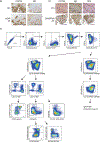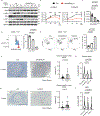Biallelic human SHARPIN loss of function induces autoinflammation and immunodeficiency
- PMID: 38609546
- PMCID: PMC11626442
- DOI: 10.1038/s41590-024-01817-w
Biallelic human SHARPIN loss of function induces autoinflammation and immunodeficiency
Abstract
The linear ubiquitin assembly complex (LUBAC) consists of HOIP, HOIL-1 and SHARPIN and is essential for proper immune responses. Individuals with HOIP and HOIL-1 deficiencies present with severe immunodeficiency, autoinflammation and glycogen storage disease. In mice, the loss of Sharpin leads to severe dermatitis due to excessive keratinocyte cell death. Here, we report two individuals with SHARPIN deficiency who manifest autoinflammatory symptoms but unexpectedly no dermatological problems. Fibroblasts and B cells from these individuals showed attenuated canonical NF-κB responses and a propensity for cell death mediated by TNF superfamily members. Both SHARPIN-deficient and HOIP-deficient individuals showed a substantial reduction of secondary lymphoid germinal center B cell development. Treatment of one SHARPIN-deficient individual with anti-TNF therapies led to complete clinical and transcriptomic resolution of autoinflammation. These findings underscore the critical function of the LUBAC as a gatekeeper for cell death-mediated immune dysregulation in humans.
© 2024. This is a U.S. Government work and not under copyright protection in the US; foreign copyright protection may apply.
Conflict of interest statement
DISCLOSURE
S.P. is currently an employee of AstraZeneca and may own stock or stock options. All the other authors declare that they have no conflicts of interest.
Figures
















References
METHOD-ONLY REFERENCES
Publication types
MeSH terms
Substances
Grants and funding
- 1195038/Department of Health | National Health and Medical Research Council (NHMRC)
- 214342/Z/18/Z/Wellcome Trust (Wellcome)
- ANR-10-IDEX-0002/Agence Nationale de la Recherche (French National Research Agency)
- 413326622/Deutsche Forschungsgemeinschaft (German Research Foundation)
- MR/S00811X/1/RCUK | Medical Research Council (MRC)
- GNT9000719/Department of Health | National Health and Medical Research Council (NHMRC)
- ANR-11-LABX-0070_TRANSPLANTEX/Agence Nationale de la Recherche (French National Research Agency)
- WT_/Wellcome Trust/United Kingdom
- R21 AI159728/AI/NIAID NIH HHS/United States
- A27323/Cancer Research UK (CRUK)
- 1194144/Department of Health | National Health and Medical Research Council (NHMRC)
- ANR-20-SFRI-0012/Agence Nationale de la Recherche (French National Research Agency)
- UL1 TR001866/TR/NCATS NIH HHS/United States
- 10.23.1.013MN/Fritz Thyssen Stiftung (Fritz Thyssen Foundation)
- 414786233/Deutsche Forschungsgemeinschaft (German Research Foundation)
- 390661388/Deutsche Forschungsgemeinschaft (German Research Foundation)
- P01 AI061093/AI/NIAID NIH HHS/United States
- 2017929/Department of Health | National Health and Medical Research Council (NHMRC)
- 455784452/Deutsche Forschungsgemeinschaft (German Research Foundation)
LinkOut - more resources
Full Text Sources
Molecular Biology Databases

